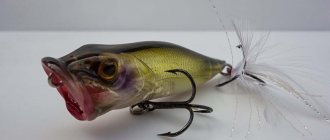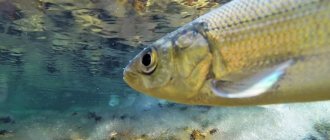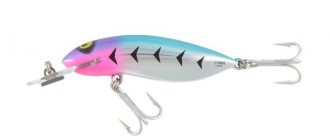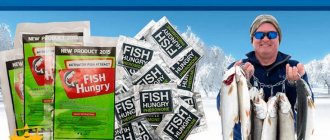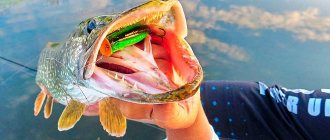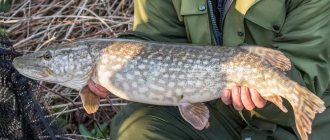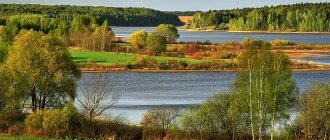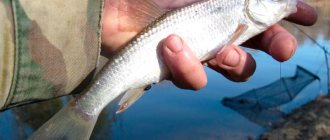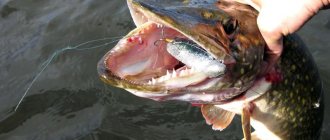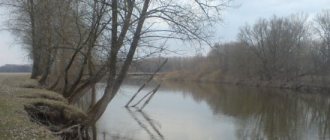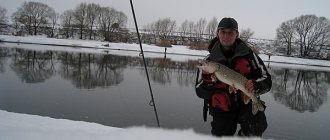What is a popper?
A popper is a type of wobbler that looks like a small fish, a frog with an open mouth, or a fairly large insect feeding on the surface. A distinctive feature is the recess in the head part. This design solution of the bait when moving contributes not only to a very loud “gurgling”, but also to splashing water around it. Translated from English, “pop” means “squish” or “gurgle”, hence the name “popper” - gurgling.
The popper was first invented and tested in action more than a hundred years ago in the USA. Popper became widespread, including in our country, in the second half of the last century.
Initially, this type of wobbler was intended as a bait for catching perch, but later it became clear that the popper could be successful for catching other predators.
Top 10 best poppers for pike
Determining the most catchy poppers for pike fishing is a thankless task. This assessment is subjective and may change over time. Nevertheless, we have selected the 10 best models, according to experts, with which fishing for pike with a spinning rod practically guarantees a catch in a variety of conditions.
Megabass pop x
Despite its apparent simplicity, this is far from an ordinary fish imitation. There is a heavy ball inside, which causes the bait to yaw and wobble when retrieving. The holes in the body through which water passes as it moves cause gurgling and splashing, which quite plausibly imitates the feeding of small fish on the surface. Length – 64 mm, weight – 7 grams.
Daiwa td popper zero
Floating popper from Japan. Its peculiarity can be considered the realism in the imitation of a fish, especially the eyes and scales. Weight – 6 grams, length – 65 mm, makes squelching sounds when inserted. Designed specifically for shallow water fishing.
Owner gobo popper
The small size perfectly imitates a feeding fry, making gurgling, slurping sounds. The bait is perfectly balanced and allows long casts, which is facilitated by the heavy ball located inside. The housing is resistant to external mechanical influences. Length – 60 mm, weight – 6.3 grams.
Yo-zuri 3d POPPER 90
Heavy, large pike popper. Made of ABS plastic reinforced with metal, which also acts as a load. The wide mouth ensures resistance when retrieving, the bait has excellent flight characteristics. Length – 90 mm, weight – 24 g.
Yo-zuri 3db POPPER 75f
A surface popper with an excellent finish that realistically imitates a real fish. The imitation is successfully supplemented with a light reflection system, which attracts the predator with its glare, and not just the gurgling sound produced by the bait. Length 75 mm, weight – 10 grams.
Berkley frenzy popper
It has a shape characteristic of all types of poppers, allowing the bait to make gurgling sounds when retrieved. Made of plastic for long service life. Length – 70 mm, weight – 9 grams.
Pontoon 21 Preference POPPER 65
Small and medium-sized pike regularly “sit” on this universal popper. This model works best in jerky animation, simultaneously tempting perch. A ball mounted inside ensures that the bait moves from side to side. It has good aerodynamic properties and flies far. The length of the bait is 65 mm, weight is 10.5 grams.
Strike Pro GIANT POP 160
Heavy classic popper for pike, 160 mm long and weighing 85 grams. Thanks to its significant weight, it allows you to make long casts and fish remote areas of the water area with an eye on large predators.
River 2 sea bubble pop
A decent factory bait of Chinese origin. Inside there is a special weight system that ensures long and accurate casts. Slots on the sides of the head allow the bait to make a gurgling sound when retrieving it.
Fishycat popcat 85 f
When conducting, it makes loud sounds that can be heard from a great distance, which allows you to attract a predator from afar. Length – 85 mm, weight – 9.2 grams.
Design Features
A popper is characterized by the absence of blades. There is a bevel in the head part, the shape and size of which affect the volume of gurgling and its tonality. Some popper models have gill cutouts on the side. The body can be either conical or elongated.
As a rule, such a wobbler has not only a pair of tees, but also tail feathers. There are models that are equipped with so-called “rattles”, which are responsible for additional acoustics, or special chambers for attractants.
To improve the “flight” characteristics, the poppers are equipped with a long-distance casting system. The flight range is ensured by the movement of the load when thrown into the tail of the popper. Some “bottle” poppers have a fixed weight. As a result, during a pause, the tail part of the popper goes under the water, and only the head of the bait remains on the surface.
Operating principle
The operating principle of the popper is as follows: thanks to the concave part of the body of the bait, water bubbles get inside and almost immediately fly out of it with a characteristic “squelching” sound. In addition, the movement of the popper is accompanied by all-round spraying. This extraordinary behavior of the popper resembles a wounded fish or small fry. It is very difficult for a predator to stay away from such a seductive action.
After casting, this type of wobbler lies downhill, with its sloping mouth and head looking up. At the slightest jerk of the spinning rod, the popper goes out of the water, swallowing air bubbles, and almost immediately emerges, squelching and splashing around.
Where to use the popper
The scope of application of poppers is very wide. They are especially effective in places where it is difficult to use baits with great depth, and this can be not only water areas overgrown with grass, but also open water. But the priority is to fish with a popper in places where there is more aquatic vegetation than water (both on the surface and near the bottom). Such places include shallow toad grasses, snags, peat bogs and river bays.
The key feature of such places is the accumulation of fry. This means the presence of predators nearby. In the absence of waves, the popper is clearly visible on the water surface and the likelihood of successful fishing increases significantly.
Often, good results are achieved by casting a popper under overhanging tree branches or into gaps between water lilies. For these purposes, in addition to a special skill, a boat is usually required.
Not only predatory fish, but also peaceful fish readily respond to the popper. Among the most popular “victims” of the popper are: pike and perch, asp and ide, rudd and chub. Pike perch bites on poppers also occur, but much less frequently. Under certain conditions, catfish can also attack a popper, since the sound of this bait is similar to the sound made by a quok.
Features of seasonal pike fishing with popper
The season begins in late spring and continues until the first frost.
in spring
In the spring, when pike recover from the cold, a good place to fish is shallow water. The water there is warmer and there is more food for the predator.
In different latitudes of the country, fishing for pike begins after freeze-up, before spawning. At this time, the predator accumulates strength and hunts not at depth, but on the surface in shallow places.
In summer
Summer fishing includes features:
- Fishing for pike with a popper in mid-summer is carried out next to pike shelters. Shelters are located among algae, under snags, in the shade of trees, etc.
- An excellent time of day for fishing is morning and evening twilight, as well as cloudy weather.
- During rain and thunderstorms, the predator bites the bait more actively, especially away from shelter, but fishing in bad weather can be dangerous.
If fishing occurs in strong winds, it is worth taking stronger gear and spare baits with you.
When to use a popper
The optimal period for using poppers as bait in the middle zone is from May to September. It is at this time that underwater vegetation begins to bloom, and the fry accumulate on the surface, using algae as shelters. In addition, various insects are rapidly emerging, and the activity of frogs is increasing.
During the day, the best time for popper fishing is evening. Zhor usually begins 2 hours before sunset and stops with the onset of darkness. Fishing at night is possible, but it is quite difficult, since there is no way to visually monitor the bait.
The popper is also effective in the morning: from the very sunrise. For about three hours the bite is usually good, and then the number of bites begins to decline.
What is the best time to fish?
Popper fishing can be done throughout the open water season, but the best time to fish for popper is from late May to mid-August. The popper shows its greatest effectiveness in the hottest time of the year, when the predator, due to the low oxygen content in the water, prefers to stay closer to the surface, in the upper layers of the reservoir, notices a moving bait and instantly rushes at it.
Popper fishing is best during the early morning hours and before sunset. At this time, predators are at their maximum level of activity.
For popper fishing, you should choose calm, windless weather. Rain, wind and waves on the surface prevent the popper from making characteristic squelching sounds, which deprives it of a significant share of its attractiveness in the eyes of a predator.
Popper selection criteria
When choosing a popper, you should pay attention to such parameters as:
Popper size
Popper size is one of the key parameters. Small poppers (up to 5 cm) are readily used to bite small perch and gar weighing up to 200 grams, so it is not advisable to use them. But, starting with baits longer than 5 cm, there is a chance to catch perch up to half a kilogram and medium-sized pike.
Closer to autumn, poppers 8 cm long are more effective, and with the onset of cold weather and up to the ice, large poppers up to 12 cm long have proven themselves better.
The weight of the popper varies from 4 to 20 grams. There are also larger poppers weighing up to 40 grams, but this is rather an exception to the rule. The weight of the popper is selected depending on what predator it will be used on.
Material
Poppers are produced on an industrial scale using hard materials such as wood and plastic. At the same time, plastic baits are more in demand due to their practicality and durability.
Elastic poppers are better because the quality of the sound they produce is higher. If desired, you can make poppers yourself. In this case, you can use hard foam and cork as the material for their manufacture.
Colors
The color of the poppers does not play a key role and can be absolutely anything. The predator sees the bait from below against the sky, which is why it should be contrasting from the bottom. But the color of the upper side of the bait is much more important. It is important for the angler to see the popper from a distance in order to control the retrieve more accurately. A bright color in this case is more advantageous.
As a rule, this part of the popper is painted in bright red tones. If this is not the case, the frontal part of the bait can be tinted with nail polish. For these purposes, varnish with a fluorescent effect is better suited.
Despite the fact that the color of the popper is not so important, under different fishing conditions (fishing season and time of day, water light level), certain colors may be more catchy than others. The most commonly used poppers are silver, yellow-orange, and white with a red face.
Popper shape
According to their geometry, poppers are divided into:
- thin (pencil) poppers provide a strong splash of water on the sides with a slight “spitting” Pencil poppers have proven themselves well for catching a passive predator in cold water;
- thick (conical) ones are characterized by a loud gurgling and impressive splashing, but go relatively straight. Cone poppers are indispensable for fishing in strong waves.
Loading location
Poppers are classified according to loading location as follows:
- front-loaded - most of the weight is shifted to the popper's muzzle;
- rear-loaded - the main part of the weight is concentrated in the rear part of the bait;
- equally loaded - the load is evenly distributed throughout the body.
Checking the load on the popper is very easy. To do this, you need to place it in water and visually determine which of its parts is more recessed: the head, the back, or evenly.
Which popper to choose for pike
Every spinning player has his own favorite poppers, but in order for such to appear, you need to know where to start your choice.
The website ryba4ok.ru will tell you which poppers you should choose for catching pike with a spinning rod. Size. It is optimal to choose a popper 5-13 cm. Typically, catchy poppers have sizes within these limits, although there are also poppers from well-known and high-quality manufacturers with a length of 25 cm.
Color. Experienced anglers, when choosing the color of a popper, are guided by the transparency of the water or the time of fishing. But, of course, these rules do not always work and you need to experiment and determine the most successful and catchy colors yourself. And some anglers generally believe that the color of the popper is not at all important when fishing for pike, since it only sees its lower part. Below we will consider the basic rules for selecting bait colors.
Light or brightly colored poppers work better in murky water as they will be more visible and easier for the fish to see. In clear and clean water, dark poppers are better suited, as they will not be too intrusive and will not scare off predators.
Experienced fishermen claim that at dawn, pike prefer poppers of black, red and orange colors.
These are tips based on experience, but you should understand that they do not always work and that each body of water is individual. Moreover, not a single good fisherman became such only thanks to the advice of others - everything was tested and verified personally, although, of course, it is worth listening to the advice of experienced ones.
How to fish with a popper
The technique of wiring a popper is not at all trivial, as it might initially seem. Since it does not have blades, it will not be possible to move the bait evenly.
For a popper, jerk animation or twitching is effective. To make a jerk, just slightly twitch the tip of the rod. Then, during a pause, the slack in the fishing line is pulled out. When retrieving, the main thing is to make the popper make as much noise as possible and splash on the water surface in order to attract the attention of a potential victim.
There are several options for jerk animation used in popper fishing:
- classic animation is suitable for catching active predatory fish. To carry out such wiring, it is necessary to slowly rotate the reel at the same speed and at the same time make jerks of equal amplitude with the rod;
- slow retrieve is effective for a passive predator. It is based on a large number of long pauses and stops;
- chaotic animation is good in the fall. A distinctive feature of chaotic wiring is the sudden movements of the bait. After several amplitude jerks there is a short pause (up to 3 seconds). In the absence of a bite, such an animation can bring results;
- pulsating wiring imitates the movement of a frog. By supporting the rod tip, the popper is given a slight acceleration, after which the reel is reeled in at the same speed. As a result, the bait glides slowly, and then accelerates again after twitching the tip of the spinning rod.
The optimal variation of wiring should be selected experimentally, taking into account the mood of the fish in the fishing area and the temperament of the spinning fisherman. To do this, it is necessary to alternate pauses and their duration, vary the strength, amplitude and frequency of jerks.
Experienced anglers only need a few minutes to determine the optimal fishing technique. When properly animated, the popper makes a seductive, never-ending sound.
Useful tips
Often the fish chases the popper, but does not dare to attack it. In this case, you need to change your playing style. For example, perch reacts more readily to short jerks, while the presence of pauses does not play a significant role.
It is important to remain quiet when fishing with poppers. Especially when fishing from a boat. In this regard, it is preferable to use conventional boats with a flat bottom. It is not recommended to fish from duralumin boats, which make a lot of noise when moving, thereby frightening the predator.
One of the most common mistakes when using a popper is moving it too fast. Fast retrieving can be quite effective, but still, as a rule, when the popper moves slowly, the number of bites is greater.
It is extremely important in a situation where it is not possible to improve the quality of the popper, to show your fishing skills, namely to find the right wiring.
- Wobblers for pike in spring. Rating of the best
- The best spoons for pike
- Color of silicone lures
- Drop shot rig
Fishing places where bait is used
It is used mainly in various shallow waters, preferably without current. Where there is little water and a lot of duckweed and grass:
- shallow bays;
- floodplain lakes;
- overgrown river oxbows;
- marshy ponds.
Productive fishing can also be:
- In the warm season, on clean water, at dawn. At this time, the fish are most active.
- You can hunt from a boat, under overhanging trees. Only here you need some experience.
